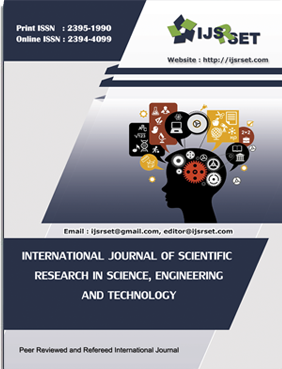Medicine Identification for Blind People by Deep Learning Techniques
Keywords:
Convolutional Neural Network, LeNet, Alex Net, Image Processing Techniques, PythonAbstract
Giving blind people with great accessibility to their environment is of great demand. People with visual impairments experience a lot of problem in using the modern assistive device that limits their daily basic activities. The level of assistance provided of these special aids does not meet the consumer requirements and not affordable by the every section of the society. To overcome the some of the limitations of the existing visual aids, in this paper we present the work that helps the visually impaired person with smart glasses to identify the medicine. The name of the medicine can be read by the smart glass system that provides audio signal through the ear phones. The smart glass system reads the medicine name using Convolutional neural network.
📊 Article Downloads
References
Aditya Wagh, Kantian Dhoti , Karmic Ingle, “Real Time Image Processing on Single Board Computer”, Imperial Journal of Interdisciplinary Research, vol.2, Issue-7, 2016.
M. B. Blaschko and C. H. Lampert,“Learning to localize objects with structured output regression”, Computer Vision– ECCV, pp. 2–15. Springer, 2008.
L. Bourdev, J. Malik. Poselets,“Body part detectors trained using 3D human pose annotations”,proceedings in International Conference on Computer Vision (ICCV), 2009.
U. Bodenhausen, S. Manke, “Automatically Structured Neural Networks for Handwritten Character and Word Recognition”, pp. 956– 961,1993.
D. Dakopoulos, N. G. Bourbakis, “Wearable obstacle avoidance electronic travel aids for blind: A survey,” IEEE Trans. Systems, Man, Cybern., vol. 40, no. 1, pp. 25-35, 2010.
Dan, UeliMeier,JurgenSchmidhuber, “Multi-column deep neural networks for image classification.” IEEE Conference on Computer Vision and Pattern Recognition, NY: Institute of Electrical and Electronics Engineers (IEEE), 2012
Ushizima, Daniela, Allan Carneiro, Marcelo Souza, and Fatima Medeiros. "Investigating pill recognition methods for a new national library of medicine image dataset." In International Symposium on Visual Computing, pp. 410-419. Springer, Cham, 2015.
Yaniv, Ziv, Jessica Faruque, Sally Howe, Kathel Dunn, David Sharlip, Andrew Bond, Pablo Perillan, Olivier Bodenreider, Michael J. Ackerman, and Terry S. Yoo. "The national library of medicine pill image recognition challenge: An initial report." In 2016 IEEE Applied Imagery Pattern Recognition Workshop (AIPR), pp. 1-9. IEEE, 2016.
Calix, Ricardo A., Ravish Gupta, Matrika Gupta, and Keyuan Jiang. "Deep granulator: Improving precision in the classification of personal health-experience tweets with deep learning." In 2017 IEEE International Conference on Bioinformatics and Biomedicine (BIBM), pp. 1154-1159. IEEE, 2017.
Chang, Wan-Jung, Liang-Bi Chen, Chia-Hao Hsu, ChengPei Lin, and Tzu-Chin Yang. "A deep learning-based intelligent medicine recognition system for chronic patients." IEEE Access 7 (2019): 4444144458.
Ervasti, Mari, Minna Isomursu, and Igone Idigoras Leibar. "Touch-and audio-based medication management service concept for vision impaired older people." In 2011 IEEE International Conference on RFIDTechnologies and Applications, pp. 244-251. IEEE, 2019.
Ou, Y.-Y., Tsai, A.-C., Zhou, X.-P. and Wang, J.-F. (2020), Automatic drug pills detection based on enhanced feature pyramid network and convolution neural networks. IET Comput. Vis., 14: 9-17. https://doi.org/10.1049/iet-cvi.2019.0171
L. S. Cordeiro, J. S. Lima, A. I. Rocha Ribeiro, F. N. Bezerra, P. P. Rebouças Filho and A. R. Rocha Neto,"Pill Image Classification using Machine Learning," 2019 8th Brazilian Conference on Intelligent Systems (BRACIS),2019, pp. 556-561, doi: 10.1109/BRACIS.2019.00103.
W. Chang, L. Chen, C. Hsu, J. Chen, T. Yang and C. Lin, "MedGlasses: A Wearable Smart-Glasses-Based Drug Pill Recognition System Using Deep Learning for Visually Impaired Chronic Patients," in IEEE Access, vol.8, pp. 17013-17024, 2020, doi: 10.1109/ACCESS.2020.2967400.
Urja Patel, "Machine Learning-based Pharmaceutical Tablet Inspection and Recognition Techniques – A Review", 2021 International Conference on Artificial Intelligence and Smart Systems (ICAIS), pp.220-222,2021.
S. Bashyal, R. K. Subba, S. Adhikari and L. Wagle, "Medication utilization problem among blind population inNepal", Int. J. Pharmaceutical Sci. Res., vol.10, pp. 1959-1965, Apr. 2019.
Downloads
Published
Issue
Section
License
Copyright (c) 2024 International Journal of Scientific Research in Science, Engineering and Technology

This work is licensed under a Creative Commons Attribution 4.0 International License.




